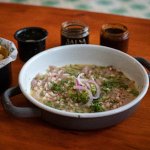National Ceviche Day in Peru Date in the current year: June 28, 2026
 National Ceviche Day (Día Nacional del Ceviche) is a Peruvian holiday observed annually on June 28. It celebrates one of the most famous dishes of Peruvian cuisine, which is very popular in the Pacific coastal regions of Latin America.
National Ceviche Day (Día Nacional del Ceviche) is a Peruvian holiday observed annually on June 28. It celebrates one of the most famous dishes of Peruvian cuisine, which is very popular in the Pacific coastal regions of Latin America.Ceviche (also spelled cebiche, seviche, or sebiche) is a dish consisting of chopped fresh raw fish marinated in fresh lime or lemon juice and spiced with finely chopped onions, ají pepper, chili pepper, salt, and coriander. As we’ve already mentioned, ceviche is popular in many Latin American countries, but it is believed to have originated in Peru.
The word “ceviche” has the same etymology as the word “escabeche”. The latter is a Spanish and Portuguese dish consisting of marinated fish or meat cooked in a vinegar-based sauce. It originated in the Arabian Peninsula and was brought to Spain during the Umayyad conquest of the Iberian Peninsula. Centuries later, Spanish conquistadors brought escabeche to South America.
Although the names of the dishes seem to have the same origin, Peruvians claim that ceviche has a pre-Hispanic origin and was made by indigenous civilizations nearly 2,000 years ago. However, most historians agree that the dish originated during the colonial times. Be that as it may, there is little doubt that the region it originated in was present-day Peru.
Traditional-style Peruvian ceviche is composed of raw saltwater fish, typically corvina or sea bass. Fish chunks are marinated in freshly squeezed key lime juice that causes the proteins in the fish to become denatured, and mixed with sliced onions, chili peppers, salt and pepper. Ceviche is usually served as an appetizer, but it can also be served as a main dish with a side of corn on the cob and cooked sweet potatoes.
The classic recipe called for marinating the mixture for several hours, but modern-style ceviche, popularized about half a century ago, is usually marinated for a very short time and is typically served right after all the ingredients are mixed together. Since the fish is eaten raw, the dish is prepared fresh and served immediately to minimize the risk of food poisoning.
From Peru, ceviche has spread throughout Latin America, and each country has its own distinct variation of the dish. In Ecuador, for example, it can be made with shrimp, shellfish, octopus, or crab. In addition, Ecuadoran ceviche usually contains tomato sauce. Chilean ceviche is often made with Patagonian toothfish or halibut, marinated in a mixture of grapefruit and lime juices, and spiced with red chili peppers and finely minced garlic, cilantro and fresh mint.
In Mexico, ceviche is usually made with tomato sauce and served in cocktail cups, on tostadas, or as a taco filling. A popular ceviche variant in Nicaragua and Salvador is ceviche de concha negra (“black conch ceviche”), noted for its dark, nearly black color and distinct flavor.
In 2004, the National Institute of Culture of Peru officially included ceviche in the list of the cultural heritage of the nation. Four years later, the Ministry of Production of Peru declared June 28 as National Ceviche Day to highlight the importance of the dish in Peruvian cuisine and its cultural significance.
- Category
- Cultural Observances
- Country
- Peru
- Tags
- National Ceviche Day in Peru, holidays in Peru, cultural observances, Peruvian cuisine, ceviche